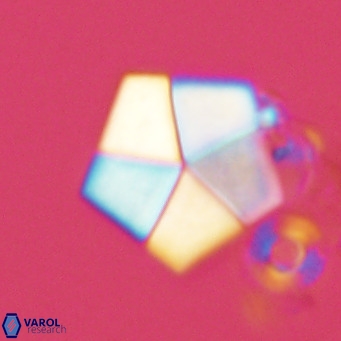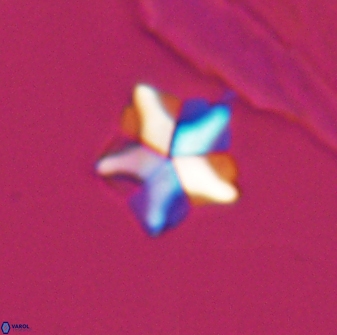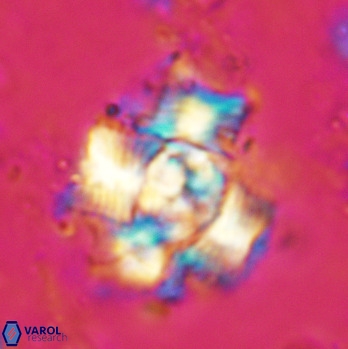Terminologies, Symbols and Abbreviations
USAGE OF "-" AND "/"
Campanian - Maastrichtian
The species ranges from Campanian to Maastrichtian.
Campanian / Maastrichtian
The age from Campanian to Maastrichtian is not clearly defined; thus, the species may range throughout this interval or may be limited to either the Campanian or Maastrichtian stages.

TERMINOLOGY
Accessory plate, a retardation plate, compensator plate: An accessory plate introduces a fixed amount of retardation; standard accessory plates are the λ-plate or the ¼ λ-plate
Amici-Bertrand Lens (Bertrand lens): It shifts the plane of focus, allowing the viewer is to observe interference figures.
Analyser (upper polariser): It forces the light rays to vibrate into one plane (90° to the polariser) and recombines all wavelengths, which results in the interference colour. An analyser is composed of long molecules aligned in one direction.
Anisotropic Minerals: Anisotropic means that the observed crystal structure of the mineral varies with the viewing direction.
Apparent angle: The observed angle when the segments are viewed obliquely rather than perpendicularly to their length.
Biomineralisation: Crystals can be derived from organisms and plants through a process known as biomineralisation.
Birefringence: Difference between the refractive indices of the slow and the fast rays (δ = nɛ-nɯ).
Blocks or crystalline block: The term refers to a zone of crystalline units within a holococcolith that acts as a single optical unit under cross-polarised light
C-axis: The c-axis in a calcite crystal is the shortened direction that indicates its threefold symmetry.
Calcareous Nannofossils: Refers to fossilised coccoliths of unicellular flagellate phytoplankton (calcareous nannoplankton) and certain calcareous forms associated with them in the same sample preparation due to their similar size, which may or may not be related.
Calcareous Nannoplankton: Refers to living marine organisms that are unicellular flagellate phytoplankton (single-celled organisms that produce calcareous bodies called coccoliths) belonging to the Domain Eukaryota, Kingdom Protista, Phylum/Division Haptophyta and Class Coccolithophyceae.
Chemosynthesis: A biological process that uses energy from chemical reactions to convert carbon into organic matter.
Coccolith: The coccolithophore produces pre-defined individual calcium carbonate units that compose the coccosphere through biomineralisation.
Coccolithophore: Calcareous nannoplankton
Coccosphere: A spherical shell comprising overlapping coccoliths covering the cell surface.
Conjugate distance: The distance along the optical axis of the lens from the principal plane of that lens to either the image plane (for an image conjugate) or the object plane (for an object conjugate) is referred to as the lens’s focal length.
Conoscopic Illustration: The mineral is viewed simultaneously from different angles in a cone of light using the maximum aperture.
Crystal habit: The distinctive external form of an individual crystal or a cluster of crystals
Crystal: The periodic repetition of atoms or groups of atoms in a long-range order.
Crystalline or crystalline unit: The term refers to a section that has the structure and form of a crystal, i.e. it consists of an ordered arrangement of crystals within a holococcolith.
Dextral imbrication (=clockwise imbrication = right-hand screw): When observed from the canter of the coccolith, the overlapping segments are consistently on the right, the imbrication direction is clockwise. This is because the overlapping segments dictate the direction of the flow or alignment.
Dextrogyre extinction lines: Extinction lines are curved lines that bend to the right (clockwise) when observed from the center of coccoliths.
Diploid: A diploid cell contains two complete sets of chromosomes, each set inherited from each parent
Distal view: Away from the center, the convex side of the coccoliths
Double refraction: An Optical property splits the light ray into ordinary (O-ray) and extraordinary (E-ray) rays in a birefringent anisotropic crystal such as calcite.
Elongation (-): Also known as length fast, the calcite has a negative elongation if the fast ray is along the c-axis.
Elongation (+): Also known as length slow, the calcite has a positive elongation if the slow ray is along the c-axis.
Elongation: Determination of which ray vibrates along the c-axis in elongated minerals.
Extinction angle: The angle between a vibration direction and the morphological reference segment (such as a crystal edge or cleavage) in a crystal section is referred to as the extinction angle. Extinction angles may help characterise species or genera. Before measuring the extinction angle, it is essential to ensure that the structural unit is observed vertically. This can be verified if the measured angle between the extinctions of that structural unit is 90°
Extinction lines (extinction position): Under cross-polarised light, the optic axis of a structural unit parallel with the vibration direction of the polariser and analyser will go extinct (dim).
Finite conjugate distance: A microscope objective focuses directly onto a specimen without needing a secondary lens.
Haploid: A cell that contains a single chromosome.
Heterococcolith: It is a type of coccolith produced internally by a coccolithophore and then extruded to form part of the coccosphere during the non-motile (diploid) stage of its life cycle. These structures are characterised by their intricate designs, which consist of numerous carefully arranged crystal units. Each unit is meticulously shaped and assembled within predefined, often circular or elliptical frames, resulting in a complex and detailed overall pattern.
Hexagonal prism: A prism has a hexagonal base and top. It is a 3D shape and, thus, is a polyhedron with eight faces, 18 edges, and 12 vertices.
Holococcolith: They are formed intercellularly during the motile (haploid) life cycle stage. It consists of calcite rhombohedral crystals or hexagonal prisms, often 0.1 µm in diameter, arranged in continuous arrays.
Incertae familiae: (Latin for “of uncertain family”) is a designation used in morphological taxonomy to indicate that the familial placement of a taxon remains unresolved.
Incertae generis: (Latin for “of uncertain genus”) is a designation used in morphological taxonomy to indicate that the generic placement of a taxon remains unresolved.
Incertae ordinis: (Latin for “of uncertain order”) is a designation used in morphological taxonomy to indicate that the ordinal placement of a taxon remains unresolved.
Inclined c-axis: The c-axis is at an angle between 1° and 89 ° to the microscope stage
Inclined extinction: the vibration directions form any angle (EA ≠ 0°, EA ≠ 45°, ≠ 90°) with morphological reference directions (i.e., cleavage and edges). Also called oblique extinction (Kerr, 1959). Inclined optic axis: The optic axis is at an angle between 1° and 89 ° to the microscope stage
Indicatrix axis X, Y, Z: The indicatrix axes represent the vibration directions, with each axis aligned to the vector of the corresponding refractive index.
Infinite conjugate distance: A type of microscope objective projects images to infinity, requiring a tube lens to focus the image for further magnification and imaging.
Interference colours: The colours observed under cross-polarised light are called interference colours. Interference colours are categorised by first-, second, third-, and fourth-order colours.
Interference figures: Interference figures are optical phenomena observed in a Conoscopic setting. They consist of isogyres, which create a dark cross superimposed on a circular pattern of coloured rings known as isochromes. These figures provide valuable insights into the optical properties of minerals and other crystalline materials.
Isotropic Mineral: Minerals exhibit the same crystal structure in every direction.
Kryptococcolith: The taxonomic status of unique forms associated with or related to calcareous nannofossils was previously uncertain due to their markedly different morphology from typical calcareous nannofossils. Nevertheless, their calcareous composition and presence in the same preparations, attributable to similar sizes, indicated a potential connection. The discovery of their coccospheres confirmed that these forms are indeed calcareous nannofossils. This group includes species from the families Nannoconaceae and Braarudosphaeraceae.
Laevogyre extinction lines: Extinction lines are curved lines that bend to the left (counterclockwise) when observed from the centre of coccoliths.
Length fast: see elongation (-)
Length slow: see elongation (+)
Nomarski prism: A modified version of the Wollaston prism is utilised in differential interference contrast microscopy, named after its inventor, the Polish and naturalised French physicist Georges Nomarski. Like the Wollaston prism, it comprises two birefringent crystal wedges (e.g., quartz or calcite) cemented together at the hypotenuse, often employing Canada balsam. One wedge is identical to a conventional Wollaston wedge, with its optical axis oriented parallel to the prism’s surface. The second wedge is modified by cutting the crystal so that its optical axis is inclined obliquely to the flat surface of the prism. This modification causes the light rays to converge at a focal point outside the prism’s body, allowing greater flexibility in the microscope setup by enabling the prism to be actively focused.
Non-primitive unit cells: Include additional lattice points, which may be located on a face or within the cell (face-centred) or within the unit cell (body-centred), resulting in more than one lattice point per unit cell.
Numerical aperture (NA): A crucial value indicates a microscope objective lens’s ability to gather light and resolve fine details in a specimen at a fixed distance. It is vital in determining the performance characteristics of the lens.
Obliquity: Axial tilt, as defined in planetary science. In the context of extinction angles, obliquity influences the apparent angle between extinctions, making it less than or equal to the actual extinction angle (90°) unless measured precisely perpendicular to the segment length.
Optic axis (OA): It is the direction that is perpendicular to a circular section of the indicatrix with a nɯ radius for the uniaxial mineral calcite. Light along the optic axis is not polarised, and there is no double refraction.
Optical indicatrix for calcite: The optical indicatrix of calcite is an imaginary three-dimensional oblate (like a mandarin) for defining refracting indexes and vibration direction for the light passing in any direction through the calcite crystal.
Orthoscopic illumination: The mineral is viewed perpendicular to the path of light.
Parallel extinction: Also called straight extinction (i.e., Raith et al., 2011). The directions of vibration are parallel to the morphological reference. directions (EA = 0°).
Placolith: Coccolith exhibit two delicate plates stacked atop each other.
Polariser (=Lower Polariser): The polariser transforms the light from the
source directed into a vibrating E-W orientation at 90° to the analyser. A polariser is composed of long molecules aligned in one direction.
Primitive Unit Cell: A unit cell containing a single lattice point in the crystal is known as a primitive unit cell. This lattice point is located at the corners of the unit cell.
Propagation of light: The process by which electromagnetic waves transfer energy from one location to another is known as light propagation. Three key processes occur when light passes through boundaries between different media: transmission, reflection, and refraction.
Proximal view: Nearer to the centre, the concave side of the coccoliths
Radial c-axis: The c-axis is parallel to the microscope stage or vertical to the microscope axis, and the propagation of the light
Radial optic axis: The optic axis is parallel to the microscope stage or vertical to the microscope axis, and the propagation of the light
R-centred hexagonal unit cell: A hexagonal unit cell corresponds to the rhombohedral Bravais lattice and has two additional lattice points. The R-centred hexagonal unit cell can be derived from a primitive rhombohedral cell, which features a threefold rotational axis aligned with the body diagonal of the unit cell. This transformation enables the threefold rotational axis to align with one of the lattice vectors, in accordance with crystallographic conventions.
Refractive index: The bending of light as it moves from one transparent medium to another of different densities. The incident ray is refracted when it passes from the air into minerals (specific to the density and composition). The refractive index n, determined as the ratio of the speed of light in a vacuum c to the speed of light in the medium v (n = v / c)
Retardation: The difference between the refracting indexes of a slow and a fast ray as a result of thickness; it is expressed in nanometres (nm). From the retardation, visible colors, called interference colors, arise.
Rhombohedral crystal: Belongs to a unique crystal system characterised by three equal axes that are interchangeable and meet at equal angles.
Rhombohedral lattice: Within a crystal with no angles equal to 90°, but all sides are of equal length (a = b = c)
Rhombohedral unit cell: It is a right rhombic prism unit cell that is part of the hexagonal crystal family. It has two equal axes (a by a), an included angle of 120° (γ), and a height (c) that can be different from a. The height is perpendicular to the two base axes.
Segments: They consist of individually insoluble crystals, typically rhombohedral or hexagonal prisms, which serve as the fundamental building blocks for the structural units of heterococcoliths.
Sinistral imbrication (=counterclockwise imbrication = left-hand screw): When observed from the centre of the coccolith, the overlapping Segments are consistently positioned on the left; the direction of imbrication is counterclockwise. This is because the overlapping segments dictate the direction of the flow or alignment.
Snell’s law: Also known as Ibn Sahl's law. It is a fundamental law governing the relationship between the angles of incidence and refraction of light when referring to light passing through a boundary between two different substances.
sp.: the standard abbreviation for species, is used in morphological taxonomy after the generic name when a specimen cannot be confidently assigned to any described species and shows no apparent resemblance to known taxa.
Strut (pillar or buttress): Structural unit at the base of the distal process of a coccolith, supporting and connecting it to the basal plate.
Strut (Transversopontis): Structural unit at the base of the inner wall of a cribrilith, supporting and connecting it to the proximal plate.
Symmetrical extinction (EA = 45°):The vibration directions bisect the angle between two equivalent morphological reference directions (EA1 = AE2).
Uniaxial: Having a single optic axis (i.e. calcite).
Unit cell: The smallest building block and repeating unit in a crystal lattice illustrates the three-dimensional pattern of the entire crystal. Defined by lattice points, which are the locations in space where particles can vibrate, the complete lattice is created by repeating the unit cell in various directions. A crystal can be visualised as the same unit cell replicated multiple times in three dimensions.
Vertical c-axis: The c-axis is perpendicular relative to the microscope stage or parallel to the microscope axis, and the propagation of the light
Vertical optic axis: The optic axis is perpendicular relative to the microscope stage or parallel to the microscope axis and the propagation of the light.
Vibration of Light (Oscillations of Light): Light is an electromagnetic oscillation that can be likened to the transfer of energy through oscillations of particles along a path from the source to the destination. The vibration direction of a light wave (which is the direction of motion of the electric wave) is perpendicular, or almost vertical, to the direction the wave is propagating.
Wollaston prism: Invented by William H. Wollaston, this optical device is designed to manipulate polarised light. It separates incoming light into two linearly polarised beams with orthogonal polarisation, aligned according to the optical axes of the two right-angle prisms. The prism consists of two orthogonal prisms made from birefringent material, typically calcite. These prisms are cemented together at their bases, conventionally using Canada balsam, to form two right-angle prisms with perpendicular optic axes. As light exits the prism, it diverges into ordinary and extraordinary rays due to differences in the refractive indices. The angle of divergence of the outgoing beams is determined by the prisms’ wedge angle and the wavelength of the light.

SYMBOLS AND ABBREVIATIONS
BF: Bright Field Illumination
c= Speed of light in a vacuum
d: Thickness of a nannofossil or its structural units expressed in μm
DF: Dark Field Illumination
DIC: Differential interference contrast illumination
E: Extraordinary ray, fast ray in calcite
MTOTVIS: Total visual magnification of the microscope
n = Refracting index
NA: Numerical aperture of the objective lens.
nɛ: Refracting index of the extraordinary ray of calcite, smaller than nɯ
nɯ: Refracting index of the ordinary ray of calcite, larger than nɛ
O: Ordinary ray, slower ray in calcite
PH: Phase contrast Illumination
PPL: Plan polarised light (linearly polarised); only the polariser is inserted into the light path. Light is forced to vibrate only in one specific direction (E-W)
Uniaxial negative (U-): nɛ < nɯ
Uniaxial negative (U+): nɛ > nɯ
TVIS: Visually experienced depth of field.
v: The speed of light in the medium
XPL/λ: Cross-polarised illumination; polariser, analyser and gypsum plate are inserted into the light path.
XPL: Cross-polarised illumination; polariser and analyser are inserted into the light path.
δ: Birefringence
Δ: Retardation
ϑ = angular resolution
θi: The angle of incidence.
θr: The angle of refraction
λ (nm): The wavelength of a ray, often 550 nm, is used as an average value for light.
λ-plate = gypsum plate = wave plate =1st red compensator =sensitive tint plate: The λ-plate is an accessory plate, introduced at an angle of 45° to the N-S direction of the microscope (provide retardation between 530 and 570 nm). The values vary slightly according to the microscope manufacturer. Leica gives a value of 550 nm, whereas Nikon gives 530 nm.
